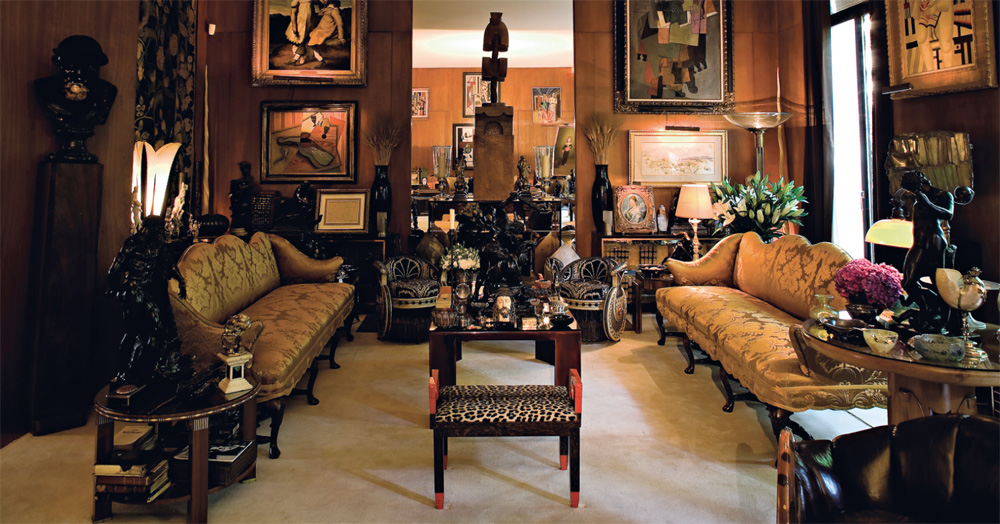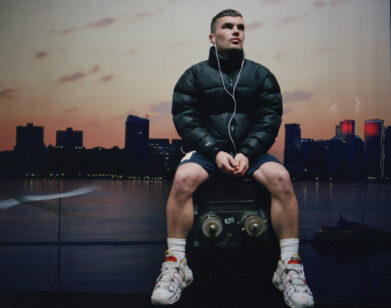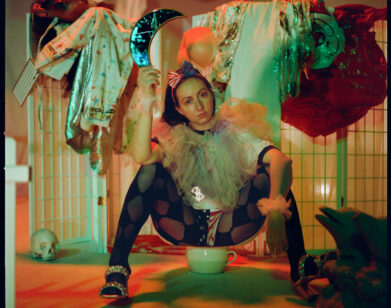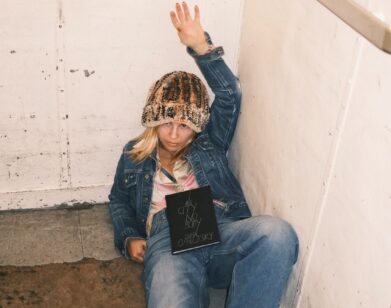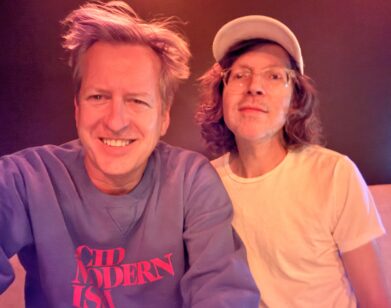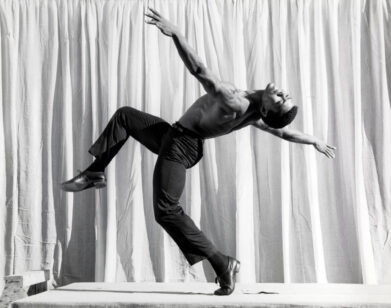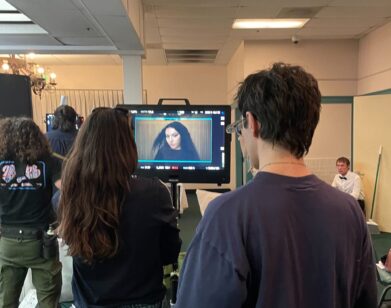Pierre Bergé: A Collector Sells All
Empire builder Pierre Bergé conspired with his longtime companion, designer Yves Saint Laurent, to create the ultimate collection. Now he’s auctioning it off. But Monsieur Bergé hasn’t got time to get sentimental. If paintings make you cry, talk to a shrink, not him.
Pierre Bergé met Yves Saint Laurent in 1958. In 1961, Bergé cofounded the couture house that bears his late longtime companion’s name. Today, at 78, Bergé, whose combination of panache and intellectual conviction gave rise to the art de vivre that is so specifically French, is one of the last great witnesses to that legendary Paris known for its supreme elegance and glamorous collections. A great friend of Jean Cocteau—he is today legal guardian of the rights to the artist’s work and is helping to establish a foundation dedicated to him in Milly-la-Forêt—Bergé remains involved in countless facets of French society. He was not only president of the Yves Saint Laurent haute couture house until 2002, he was also president of the Paris Opera from 1988 to 1994. Bergé owns the French gay magazine Têtu and is an active supporter of Ségolène Royal, the left-wing candidate in the 2007 French presidential election. He also presides over Sidaction, a leading European association in the battle against AIDS. If Bergé weren’t busy enough, current news in the auction world reveals another less public aspect of the Frenchman’s life: collecting art.
Recently, Bergé decided to part with the art collection he shared with Saint Laurent, who died of brain cancer in June 2008. The work had long been housed in their respective apartments on Rue Bonaparte and Rue de Babylone, in Saint-Germain-des-Prés. The exceptional collection—more than 700 works in total—is estimated to be worth between 200 and 300 million euros and includes an eclectic mix of antiques and modern art, pieces from Africa and Asia, art deco furniture, and enamels from the Middle Ages. Of the modern works, most prominent are four Mondrian paintings, a sculpture by Brancusi, three works by Léger, a Cézanne watercolor, and a Duchamp Dada masterpiece (one of the few still in private hands). This month in the Grand Palais in Paris, Christie’s and Bergé’s own Franco-Belgian house, Pierre Bergé & Associés, will hold the exhibition and sale of a collection owned by two men who came to define so much.
JUDITH BENHAMOU-HUET: Where exactly do you come from?
PIERRE Bergé: Geographically speaking, I was born on a French island—the île d’Oléron. Otherwise, I come from a milieu where culture was of the utmost importance. I learned music even before I learned to read. I always read books beyond my years. At the age of 9, I read David Copperfield by Dickens. At 14, I read War and Peace by Tolstoy. They’re both books I have reread regularly since. My parents were modern people, left-wing. My mother, who is today 101—she’s somewhat weaker now but up until last year she was in good health—voted for Ségolène with great vigor, even if she reproached Ségolène for not being left-wing enough and disagreed with some of her more Catholic compromises.
JBH: How would you define yourself today?
PB: I am a man who has spent more than half a century ostensibly and visibly accompanying Yves Saint Laurent throughout his life—but not only that. In the past and still today, I have been behind a lot of creators and artists, supporting them and helping them. That’s probably how I see my mission.
JBH: When you presented your art collection at Christie’s, you said, “Now I am naked.” Can you explain that phrase?
PB: What I meant was that during the period prior to the sale, when the experts were coming to see the paintings, the furniture, the artworks . . . When journalists come to interview me, it’s a part of my life that is exhibited, as if pieces of clothing are being taken off one by one. But it’s not very important really.
JBH: Not very important? Because you feel detached from the objects in your collection?
PB: I’ve been detached for quite some time. In April 2007 I learned that Yves Saint Laurent had a brain tumor, and he died on June 1, 2008. During those 14 months I had plenty of time to think about what would happen.
JBH: You seem to be a man given to both reflection and impulse. You could have changed your mind.
PB: Yes, that’s true. But I didn’t. There was only one solution: the auction. An auction establishes memory. That’s what I want to do.
JBH: What is the point of an art collection?
PB: First of all I think that building a collection is creating an oeuvre. You don’t put together a collection of this quality without being extremely demanding. It was put together by collectors who knew, who didn’t rely on dealers, who didn’t say they were looking for a Rothko because they had a wall space to fill. We bought paintings for their quality, because they were works that were inscribed in the history of painting.
JBH: You have lived with works worthy of museums. Did it affect your everyday life living alongside a Cézanne, a Matisse, and a Picasso?
PB: The works simply become part of your universe. But you don’t spend every day saying, “Gosh! That’s so beautiful.” Sometimes you look at an object more attentively and see it anew. I won’t talk of any one object in particular. For me there is no hierarchy in art. Things have an inherent quality or they don’t. A collection is like a dinner party. It is made up of the people you invite, but also
the people you don’t. There are also, of course, the ones who couldn’t make it. I would have liked to have found a Barnett Newman. I would have liked to have found a Rothko. I would have liked to have found a Pollock. I would have liked to have found a Bacon. It didn’t happen. We didn’t come across them. But in this collection you won’t find any Chagalls, no Balthus, no surrealists. And nothing by Picasso outside the cubism.
JBH: Any van Gogh?
PB: I had a van Gogh, a small Provençal landscape. We sold it. If you’re going to have a van Gogh it should be a really good van Gogh.
JBH: And the notion of possessing art, is that important?
PB: Not at all. You don’t own art. No, no, no. What does that mean? We are trustees of art. Art is in transit with us. That is why an auction is a wonderful thing. You clap your hands and the objects fly away like doves and find other places where they will be protected, loved. That’s what I believe.
JBH: You’re not selling the quadriptych portrait that Andy Warhol did of Yves Saint Laurent. Why is that?
PB: It has to stay with the Yves Saint Laurent–Pierre Bergé foundation, to which it belongs.
JBH: You often saw Warhol. How did you meet him?
PB: I can’t even remember. I met him in the ’60s, a wonderful time, with wonderful people. There was Fred Hughes, and Jed Johnson, who I liked a lot. Jed Johnson decorated my apartment in New York, at the Pierre. It was his first job. There are a few survivors from the time, like Bob Colacello.
JBH: Did Warhol have an influence on you?
PB: An influence? No. There was an exchange. We met, we liked each other, we appreciated each other. He would come to us for Easter in Marrakech. In September we would meet up in Venice. And every time I went to New York I would spend some time with him at the Factory, where we would have dinner together. He’s a man that I admired deeply. He shook up the notion of painting—not as much as Duchamp had done, but he was part of the same general movement. And then we both admired art deco. We would go antique hunting in Paris together. It was I who found Fred Hughes his Paris apartment on the Rue du Cherche-Midi, where Warhol would stay.
JBH: You also aren’t selling your collection of first-edition books?
PB: What I’m selling is the Yves Saint Laurent–Pierre Bergé collection. My library is my own -private domain. For the moment it’s important to me to -continue my involvement in one field.
JBH: This collection was conceived by you and Yves. How did that happen?
PB: We conceived it together. That’s all. Later on Yves was a lot more sedentary than me. I carried on buying paintings, works of art, and he, if I may say so, had a right of inspection. We even shared a common reading of the history of art. It would never have crossed Yves’s mind to say to me, “Ah, I saw a Picasso . . .” He knew perfectly well what was interesting with Picasso, as did I. But let’s talk about that for a moment, about the couple that Yves and I were. Like all couples we went through “storms,” as the Jacques Brel song says. But if there’s one area where we never had the slightest disagreement, it was art. Never. Not once. Not about painting, not about opera, not about theater. We were always in complete communion. Of course, that’s how all of the collection came into being.
JBH: The sale is being called the sale of the century.
PB: That may be true—of the 20th century, I suppose. For the 21st century, we can’t know.
JBH: You have been very faithful to two Parisian art dealers: Alain Tarica for paintings and the
Kugel brothers for other works of art.
PB: Not faithful. There’s no sentiment involved. On the occasions I went elsewhere I was disappointed. I buy 80 percent of the works from them.
JBH: But more generally you are the faithful type?
PB: I am faithful up to the point of death. It’s the only thing I respect. I never abandon anyone. I’m not talking about sexual relations. I’m faithful in my friendship, my admiration.
JBH: Are you moved by a sort of ideal of beauty in everyday life?
PB: In what way do you mean?
JBH: That even your toothbrush holder is beautiful, or that you pay a great deal of attention to what you eat, for example?
PB: In that sense, then yes. Yes, I am.
JBH: Are you wiping the slate clean of the past? You also sold your house in Tangier and the one in Deauville?
A collection is like a dinner party. It is made up of the people you invite, but also the people you don’t. There are also, of course, the ones who couldn’t make it.Pierre Bergé
PB: Of course not. I’ve already bought another house in Tangier and the one in Deauville has been for sale for some time. As for Yves’s apartment, it is being sold because he’s dead. But I won’t be furnishing my home from Ikea, I can promise you that much.
JBH: Are you becoming an ascetic?
PB: Of course not. I’m not an ascetic and please don’t use the word zen, which is so lightly bandied about these days. Being zen . . . It’s shameful to talk in such a way. I haven’t become an ascetic but I’m not going to build up another collection. I’m going to create my new environment. I already know what I want.
JBH: Today you are involved in many different spheres of society—politics, museums, social work. Why do so much?
PB: It’s simply a question of being in tune with my own personal choices.
JBH: Are you nostalgic?
PB: No, I hate nostalgia. Today is always better than yesterday.
JBH: Yet you’re a great fan of Marcel Proust.
PB: I love Proust, but I leave him to his nostalgia. I don’t approach art the way most people do. I don’t get into Proust by imagining that I am Charlus or whoever. It’s the same thing in painting—I try to look at it objectively. There’s no pathos in that. It’s like Bach’s “Goldberg Variations.” They have to be approached with a scalpel.
JBH: But at the end of the day you’re a cold man?
PB: Who can get carried away . . . I hate sentiment when it’s inappropriate. I saw someone two days ago who went and saw an exhibition and came out in tears. If an exhibition drives you to tears you need to see a psychiatrist immediately. That’s what I think. And that’s despite the fact that painting is the art form I prefer above all others.
JBH: And fashion?
PB: I hate it. It doesn’t as such exist. Saint Laurent hated fashion. He loved style.
JBH: In what way will Yves Saint Laurent leave his mark on history?
PB: He had an ongoing dialogue with the time he lived in and life in the streets. He had genius.
JBH: And you?
PB: I won’t make a mark on history. I have some importance in the time we live in, but that’s all.
JBH: Then what makes you want to get up in the morning?
PB: [pauses] I don’t know exactly. There’s nothing that really motivates me anymore and demands that I get up in the morning. In the past it was Yves Saint Laurent.
JBH: Why are you so fond of dogs?
PB: Because they love me. But now they’ve all died, one by one. But you know loving dogs is a question of anthropomorphism. We become attached to dogs because of the feelings we project on them.
JBH: Is freedom a fundamental element for you?
PB: From now on I am going to have a freedom such as I’ve never known. I never abandoned Yves. I used to have lunch with him twice a week. I also saw him every Saturday. My presence beside him was even more important in his bad times. But that didn’t leave me a great deal of room in which to maneuver. Freedom is an intellectual space. But I don’t use it.
JBH: And love?
PB: Love is what makes me live, quite simply. It’s the only thing that makes me work. It made me become what I am today. On my own account I certainly wouldn’t have become the director of a couture house. I didn’t have sufficient admiration for fashion as such to have done so.

